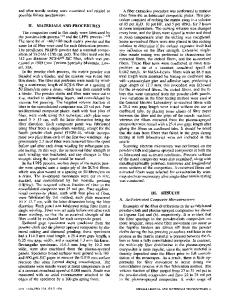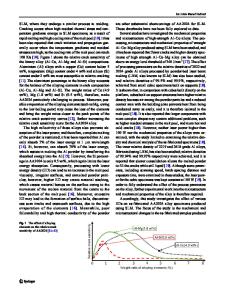The Structure and the Mechanical Properties of a Newly Fabricated Cellulose-Nanofiber/Polyvinyl-Alcohol Composite
- PDF / 204,410 Bytes
- 6 Pages / 432 x 648 pts Page_size
- 77 Downloads / 462 Views
The Structure and the Mechanical Properties of a Newly Fabricated CelluloseNanofiber/Polyvinyl-Alcohol Composite Yukako Oishi and Atsushi Hotta Graduate School of Science and Technology, Keio University, 3-14-1 Hiyoshi, Kohoku-ku, Yokohama 223-8522, Japan ABSTRACT Cellulose nanofibers (Cel-F) were extracted by a simple and harmless Star Burst (SB) method, which produced aqueous cellulose-nanofiber solution just by running original cellulose beads under a high pressure of water in the synthetic SB chamber. By optimizing the SB process conditions, the cellulose nanofibers with high aspect ratios and the small diameter of ~23 nm were obtained, which was confirmed by transmission electron microscopy (TEM). From the structural analysis of the Cel-F/PVA composite by the scanning electron microscopy (SEM), it was found that the Cel-F were homogeneously dispersed in the PVA matrix. Considering the high molecular compatibility of the cellulose and PVA due to the hydrogen bonding, a good adhesive interface could be expected for the Cel-F and the PVA matrix. The influences of the morphological change in Cel-F on the mechanical properties of the composites were analysed. The Young’s modulus rapidly increased from 2.2 GPa to 2.9 GPa up to 40 SB treatments (represented by the unit Pass), whereas the Young’s modulus remained virtually constant above 40 Pass. Due to the uniform dispersibility of the Cel-F, the Young’s modulus of the 100 Pass composite at the concentration of 5 wt% increased up to 3.2 GPa. The experimental results corresponded well with the general theory of the composites with dispersed short-fiber fillers, which clearly indicated that the potential of the cellulose nanofibers as reinforcement materials for hydrophilic polymers was sufficiently confirmed. INTRODUCTION Cellulose nanofibers are promising materials for the reinforcement of polymer composites, and the fabrication of cellulose nanofibers has been extensively investigated. It is, however, known to be quite challenging to extract cellulose nanofibers from original cellulose beads because of the strong interfacial interactions functioning between cellulose molecular chains due to hydrogen bondings. Therefore, nanofabrication processes of cellulose generally have multiple processing steps which occasionally required the use of toxic solvents or catalysts [1-4]. SB system developed by Sugino Machine Limited, Japan is one of the new simple methods fabricating cellulose nanofibers with harmless solvents. The system puts low stress on the environment because it only needs water jet, and the aqueous solution of cellulose nanofibers is easily produced just by running cellulose powder through the chamber with a high pressure of water [5]. Furthermore, the cellulose suspension obtained by SB method showed uniform dispersibility. In this study, the synthesis of the composites by SB cellulose nanofibers has been first reported, and the mechanical properties and structures of synthesized Cel-F and the Cel-F/PVA composites were analyzed. The homogenous solution of Cel-
Data Loading...











